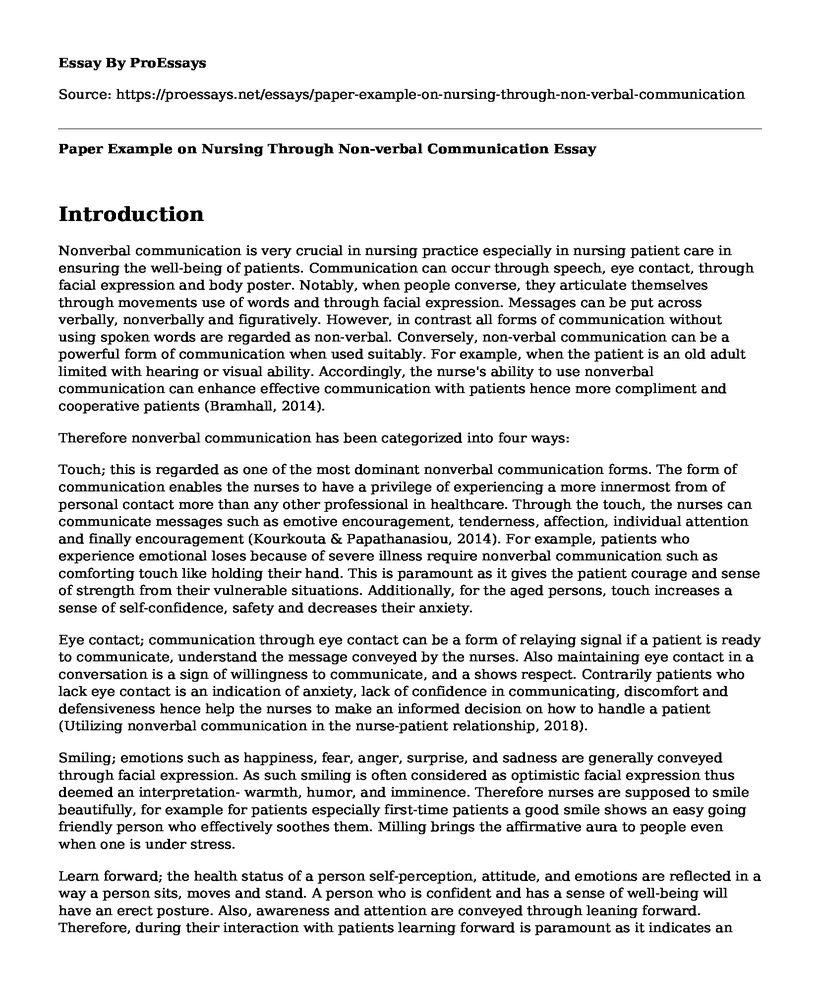Introduction
Nonverbal communication is very crucial in nursing practice especially in nursing patient care in ensuring the well-being of patients. Communication can occur through speech, eye contact, through facial expression and body poster. Notably, when people converse, they articulate themselves through movements use of words and through facial expression. Messages can be put across verbally, nonverbally and figuratively. However, in contrast all forms of communication without using spoken words are regarded as non-verbal. Conversely, non-verbal communication can be a powerful form of communication when used suitably. For example, when the patient is an old adult limited with hearing or visual ability. Accordingly, the nurse's ability to use nonverbal communication can enhance effective communication with patients hence more compliment and cooperative patients (Bramhall, 2014).
Therefore nonverbal communication has been categorized into four ways:
Touch; this is regarded as one of the most dominant nonverbal communication forms. The form of communication enables the nurses to have a privilege of experiencing a more innermost from of personal contact more than any other professional in healthcare. Through the touch, the nurses can communicate messages such as emotive encouragement, tenderness, affection, individual attention and finally encouragement (Kourkouta & Papathanasiou, 2014). For example, patients who experience emotional loses because of severe illness require nonverbal communication such as comforting touch like holding their hand. This is paramount as it gives the patient courage and sense of strength from their vulnerable situations. Additionally, for the aged persons, touch increases a sense of self-confidence, safety and decreases their anxiety.
Eye contact; communication through eye contact can be a form of relaying signal if a patient is ready to communicate, understand the message conveyed by the nurses. Also maintaining eye contact in a conversation is a sign of willingness to communicate, and a shows respect. Contrarily patients who lack eye contact is an indication of anxiety, lack of confidence in communicating, discomfort and defensiveness hence help the nurses to make an informed decision on how to handle a patient (Utilizing nonverbal communication in the nurse-patient relationship, 2018).
Smiling; emotions such as happiness, fear, anger, surprise, and sadness are generally conveyed through facial expression. As such smiling is often considered as optimistic facial expression thus deemed an interpretation- warmth, humor, and imminence. Therefore nurses are supposed to smile beautifully, for example for patients especially first-time patients a good smile shows an easy going friendly person who effectively soothes them. Milling brings the affirmative aura to people even when one is under stress.
Learn forward; the health status of a person self-perception, attitude, and emotions are reflected in a way a person sits, moves and stand. A person who is confident and has a sense of well-being will have an erect posture. Also, awareness and attention are conveyed through leaning forward. Therefore, during their interaction with patients learning forward is paramount as it indicates an interest in the discussion (Kourkouta & Papathanasiou, 2014).
Head nodding is a central function in the society that helps in regulating interactions between two parties especially where communication involves a change of turn. In nodding head, one affirms to have an understanding of what the other person is saying hence creating rapport between patients and nurses.In conclusion, nonverbal communication is very crucial in nursing practice as it is often motivated subconsciously hence reflect the intended mean g conveyed accurately than verbal communication.it also improves therapeutic communications between patients and nurses thus boosting patient satisfaction in healthcare delivery.
References
Bramhall, E. (2014). Effective communication skills in nursing practice. Nursing Standard (2014+), 29(14), 53.
Kourkouta, L., & Papathanasiou, I. V. (2014). Communication in nursing practice. Materia socio-medica, 26(1), 65.
Utilising nonverbal communication in the nurse-patient relationship. (2018). MIMS News. Retrieved 4 October 2018, from https://today.mims.com/utilising-nonverbal-communication-in-the-nurse-patient-relationship
Cite this page
Paper Example on Nursing Through Non-verbal Communication. (2022, Aug 17). Retrieved from https://proessays.net/essays/paper-example-on-nursing-through-non-verbal-communication
If you are the original author of this essay and no longer wish to have it published on the ProEssays website, please click below to request its removal:
- Application for the Post of Registered Nurse
- Medical Rhetoric Analysis Essay: What Are the Health Benefits of Being Creative?
- E-Cigarettes Smoking - Essay Sample
- Essay Sample on Advanced Practice Nursing: Education Requirements and Benefits
- Nurses' Termination: Code of Ethics & Nurse Practice Act
- Free Paper Sample on End Racial Discrimination: Upholding Equality in the US
- Understanding Varicose Vein Problems - Free Report Example







